- NEW: Rescuers meet with families to discuss new tactics to reach difficult areas of ship
- Prime Minister Chung Hong-won announces: "I should take responsibility for everything"
- Parents of a missing girl call PM's resignation "meaningless," call for President to resign
- 188 bodies from the ferry have been found, 114 are still missing
Jindo, South Korea (CNN) -- South Korea's prime minister announced his resignation Sunday morning, taking responsibility for the slow initial reaction to a ferry's sinking that has left nearly 200 dead and scores more still missing.
Prime Minister Chung Hong-won explained his decision on national television. He apologized "on behalf of the government for the many problems that arose during the first response and the subsequent rescue operation," in addition to "problems that existed before the accident."
"During the search process, the government took inadequate measures and disappointed the public," Chung said. "I should take responsibility for everything as the prime minister, but the government can assume no more. So I will resign as prime minister."
Chung urged South Koreans to stand united, rather than divided.
"This is not the time for blaming each other but for finishing the rescue operation and dealing with the accident," he said. "In order to get over these difficult times, I ask the citizens for help."
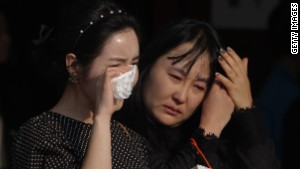 Families grieve as ferry death toll rises
Families grieve as ferry death toll rises  Who are the victims of the sunken ferry?
Who are the victims of the sunken ferry? 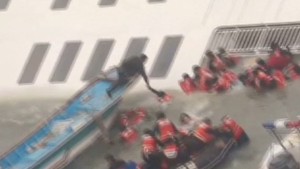 Fisherman rescued students from ferry
Fisherman rescued students from ferry Chung becomes the highest-profile public figure to fall after the April 16 capsizing of the Sewol ferry that carried more than 300 South Korean high school students. Many in the country have lambasted the government's response to the disaster. Searchers continue to still look for passengers and crew, and so far have retrieved 188 bodies. Another 114 people are still missing.
A father of a missing ferry passenger -- a girl -- called Chung's resignation "meaningless."
He and the girl's mother and sister are outraged at the government about what they say is a disorganized rescue operation.
Chung "doesn't want to take responsibility for this mess," the mother told CNN's Nic Robertson.
She felt that if President Park Geun-hye were to resign "that might actually do something."
The prime minister's role is to coordinate other ministries within government, say experts in South Korean politics. The president appoints the prime minister, and Park will choose the next prime minister.
Though the legislature can question that person before he or she takes the job, ultimately the president alone has the power to choose who gets the job, said Nicholas N. Eberstadt with the American Enterprise Institute, who has written extensively about North and South Korea.
Chung wasn't "a beloved figure, but he wasn't especially unpopular," Eberstadt said.
The capsizing of the ferry is the biggest disaster in recent South Korean history, and it's a huge story there, occupying hours and hours of news coverage, said David Straub, the associate director of the Korean Studies Program at the Walter H. Shorenstein Asia-Pacific Research Center at Stanford University.
Park is very popular, he said.
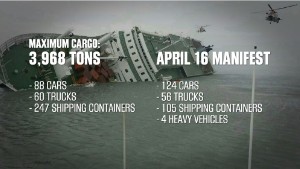 Did heavy cargo lead to ferry disaster?
Did heavy cargo lead to ferry disaster? 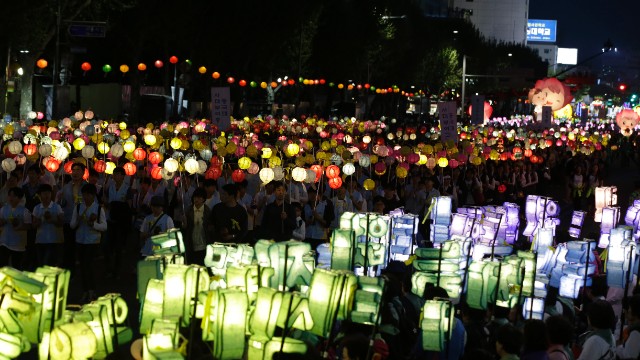 South Korean Buddhists carry lanterns in a parade in Seoul on Saturday, April 26, to honor the memory of the dead and the safe return of the missing from the sunken ferry Sewol. The parade was part of the Lotus Lantern Festival for the upcoming birthday of Buddha, on May 6. More than 100 people are dead and many more still are missing after the ferry sank Wednesday, April 16, as it headed to the resort island of Jeju from the port of Incheon.
South Korean Buddhists carry lanterns in a parade in Seoul on Saturday, April 26, to honor the memory of the dead and the safe return of the missing from the sunken ferry Sewol. The parade was part of the Lotus Lantern Festival for the upcoming birthday of Buddha, on May 6. More than 100 people are dead and many more still are missing after the ferry sank Wednesday, April 16, as it headed to the resort island of Jeju from the port of Incheon. 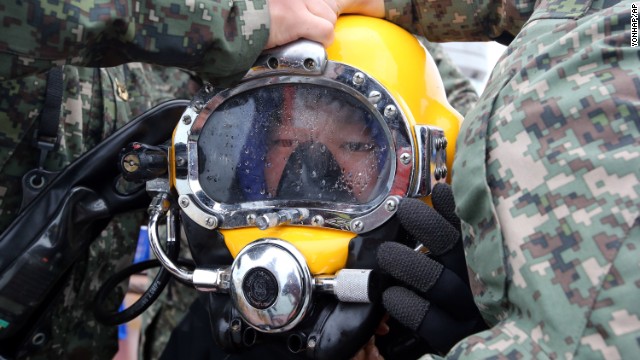 Divers search for people still missing from the sunken ferry Sewol in the waters off the southern coast near Jindo, South Korea, on April 26.
Divers search for people still missing from the sunken ferry Sewol in the waters off the southern coast near Jindo, South Korea, on April 26. 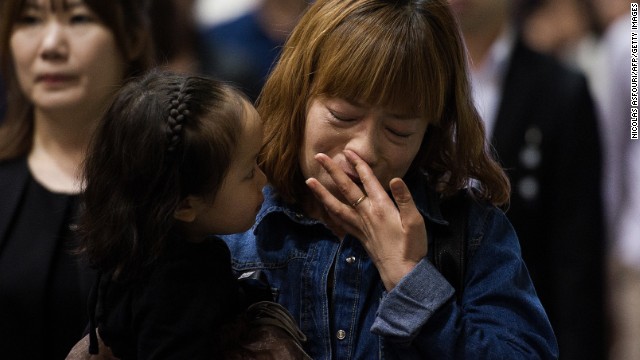 People attend a memorial for the victims of the sunken ferry on April 26.
People attend a memorial for the victims of the sunken ferry on April 26. 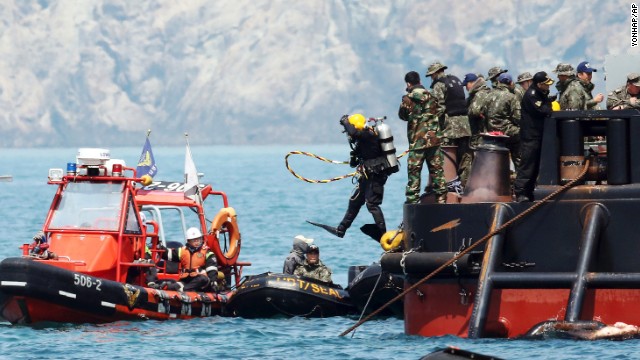 A diver jumps into the sea near the sunken ferry on Friday, April 25.
A diver jumps into the sea near the sunken ferry on Friday, April 25.  A relative of a passenger aboard the sunken ferry weeps while waiting for news of his missing loved one at a port in Jindo on April 25.
A relative of a passenger aboard the sunken ferry weeps while waiting for news of his missing loved one at a port in Jindo on April 25. 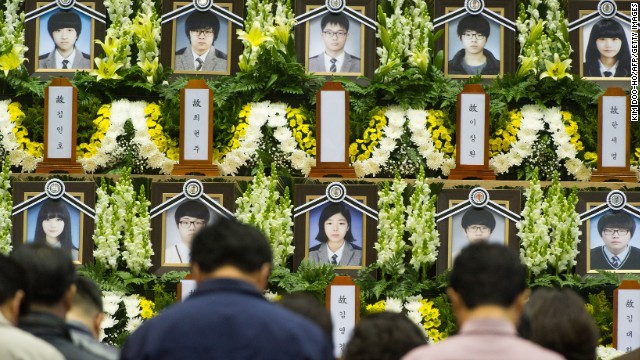 People attend a memorial for the victims of the Sewol at the Olympic Memorial Hall in Ansan, South Korea, on Thursday, April 24.
People attend a memorial for the victims of the Sewol at the Olympic Memorial Hall in Ansan, South Korea, on Thursday, April 24. 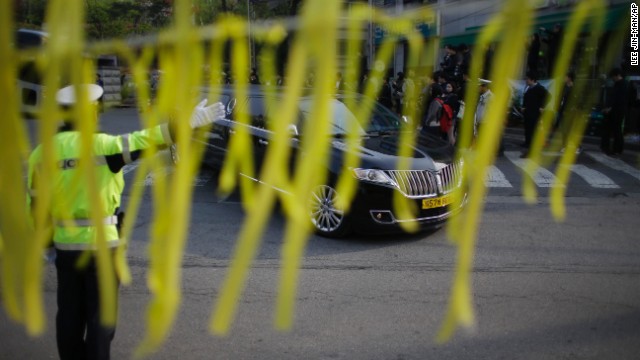 Yellow ribbons honoring the missing and dead flap in the wind as a hearse carrying the body of a victim leaves Danwon High School in Ansan on April 24.
Yellow ribbons honoring the missing and dead flap in the wind as a hearse carrying the body of a victim leaves Danwon High School in Ansan on April 24. 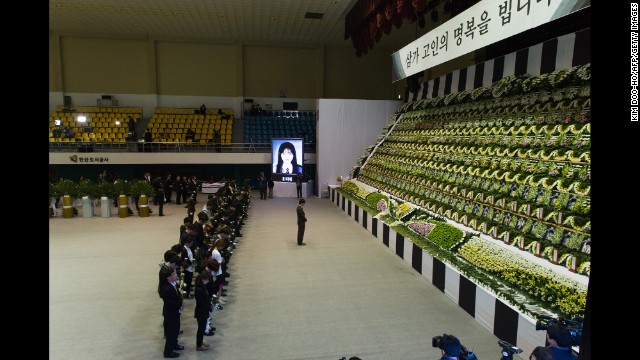 People attend a memorial for the victims at Olympic Memorial Hall in Ansan.
People attend a memorial for the victims at Olympic Memorial Hall in Ansan. 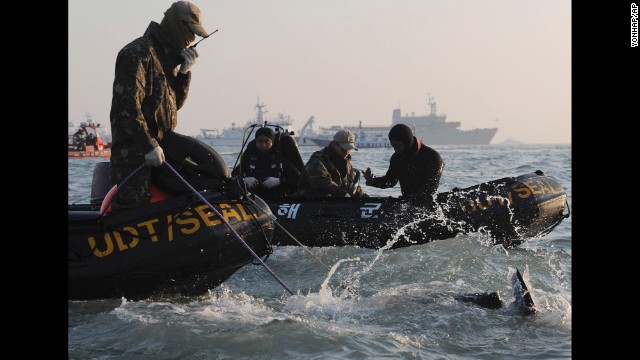 Search personnel dive into the sea on Wednesday, April 23.
Search personnel dive into the sea on Wednesday, April 23.  Flares light up the search area on Tuesday, April 22.
Flares light up the search area on Tuesday, April 22.  The sun sets over the site of the sunken ferry off the coast of the South Korean island of Jindo on April 22.
The sun sets over the site of the sunken ferry off the coast of the South Korean island of Jindo on April 22.  A relative of a passenger aboard the ferry prays as she waits for news in Jindo on April 22.
A relative of a passenger aboard the ferry prays as she waits for news in Jindo on April 22. 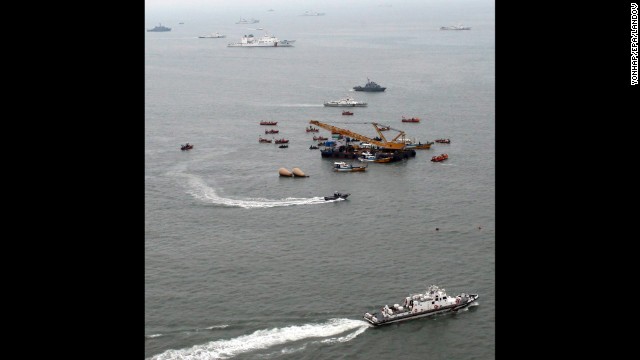 The search for victims continues in the waters of the Yellow Sea on April 22.
The search for victims continues in the waters of the Yellow Sea on April 22.  Rescue workers carry the body of a passenger on Monday, April 21, in Jindo.
Rescue workers carry the body of a passenger on Monday, April 21, in Jindo. 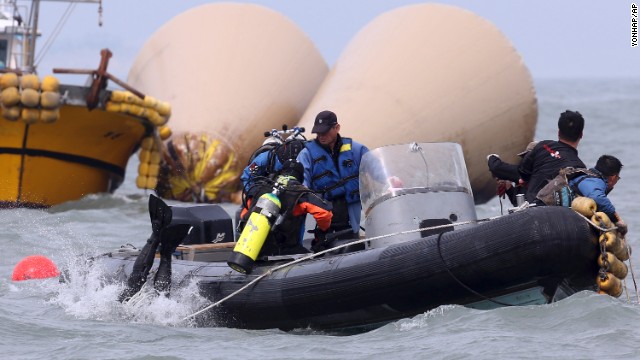 Divers jump into the water on April 21 to search for passengers near the buoys which mark the site of the sunken ferry.
Divers jump into the water on April 21 to search for passengers near the buoys which mark the site of the sunken ferry. 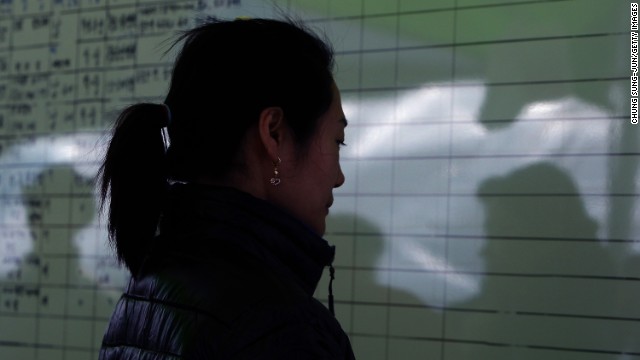 A relative of a passenger looks at the lists of the dead in Jindo on April 21.
A relative of a passenger looks at the lists of the dead in Jindo on April 21. 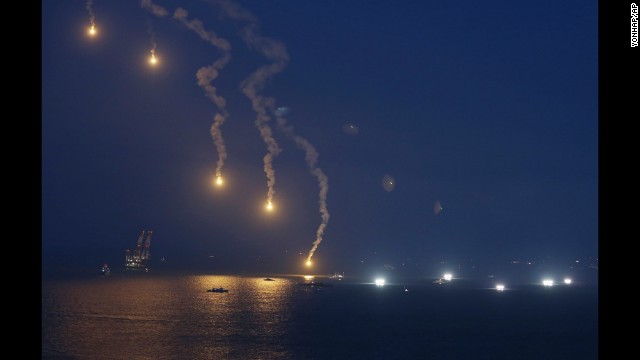 Search operations continue as flares illuminate the scene near Jindo on Sunday, April 20.
Search operations continue as flares illuminate the scene near Jindo on Sunday, April 20.  Relatives of missing passengers from the Sewol ferry grieve on April 20 in Jindo.
Relatives of missing passengers from the Sewol ferry grieve on April 20 in Jindo.  Relatives of passengers look out at the sea from Jindo on April 20.
Relatives of passengers look out at the sea from Jindo on April 20. 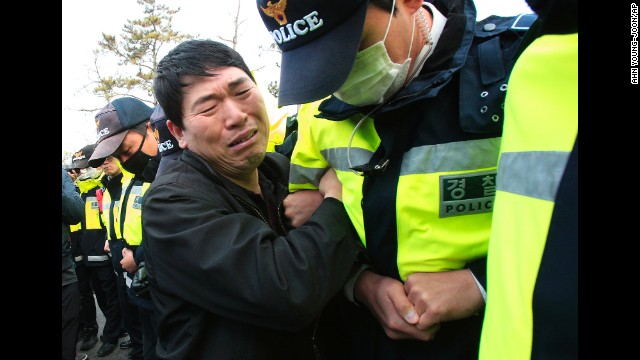 A relative of a missing passenger struggles with a policeman as he tries to march toward the presidential house in Jindo on April 20 to protest the government's rescue operation.
A relative of a missing passenger struggles with a policeman as he tries to march toward the presidential house in Jindo on April 20 to protest the government's rescue operation. 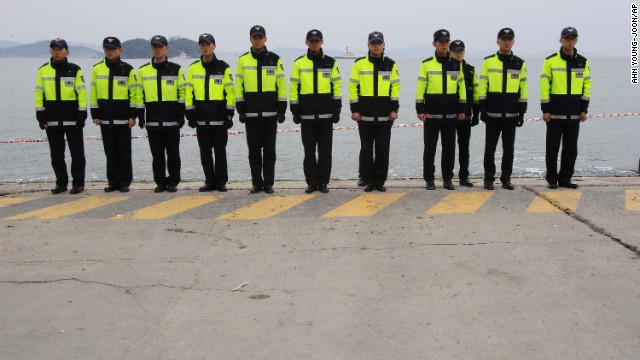 Police officers stand guard Saturday, April 19, at the port in Jindo to prevent relatives of the ferry's missing passengers from jumping in the water. Some relatives have said they will swim to the shipwreck site and find their missing family members by themselves.
Police officers stand guard Saturday, April 19, at the port in Jindo to prevent relatives of the ferry's missing passengers from jumping in the water. Some relatives have said they will swim to the shipwreck site and find their missing family members by themselves. 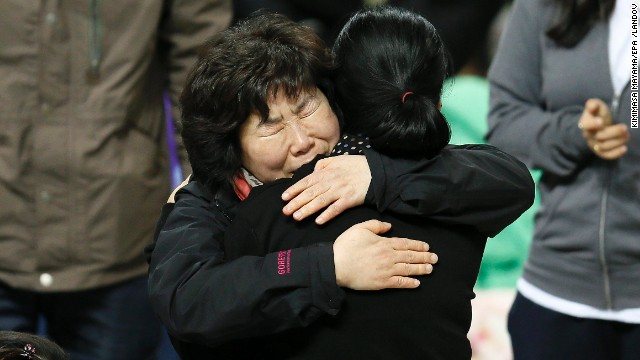 Family members of missing passengers hug as they await news of their missing relatives at Jindo Gymnasium in the southwestern province of South Jeolla, South Korea, on April 19.
Family members of missing passengers hug as they await news of their missing relatives at Jindo Gymnasium in the southwestern province of South Jeolla, South Korea, on April 19. 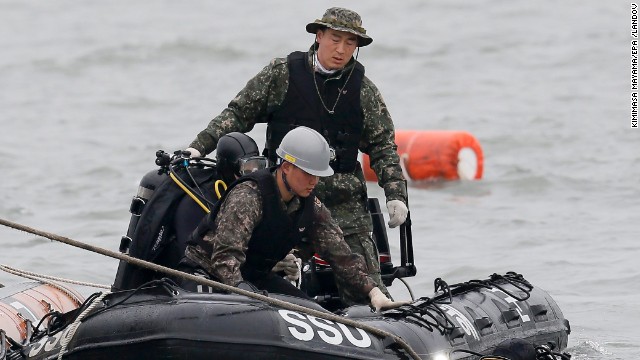 South Korean Navy Ship Salvage Unit members prepare to salvage the sunken ferry and search for missing people on April 19.
South Korean Navy Ship Salvage Unit members prepare to salvage the sunken ferry and search for missing people on April 19.  Oil from the sunken ferry appears near the wreckage site on April 19.
Oil from the sunken ferry appears near the wreckage site on April 19. 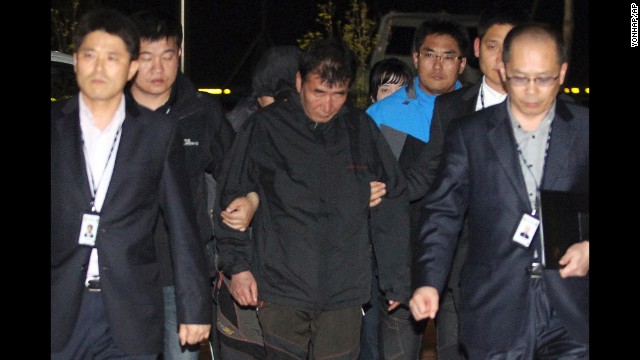 Lee Joon Suk, the captain of the sunken ferry Sewol, is escorted to the court that issued his arrest warrant Friday, April 18, in Mokpo, South Korea. It is not yet known what caused Wednesday's deadly accident.
Lee Joon Suk, the captain of the sunken ferry Sewol, is escorted to the court that issued his arrest warrant Friday, April 18, in Mokpo, South Korea. It is not yet known what caused Wednesday's deadly accident. 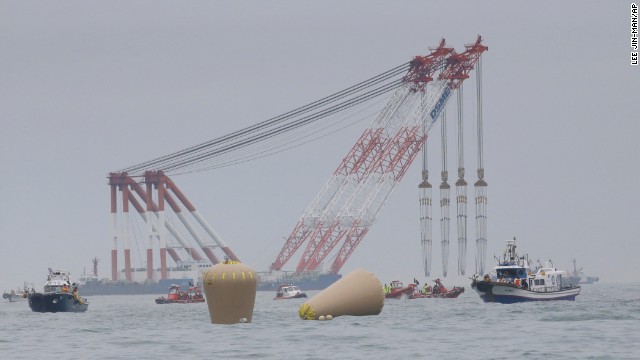 Offshore cranes wait near buoys that mark the location of the sunken ferry near Jindo, South Korea, on April 18.
Offshore cranes wait near buoys that mark the location of the sunken ferry near Jindo, South Korea, on April 18. 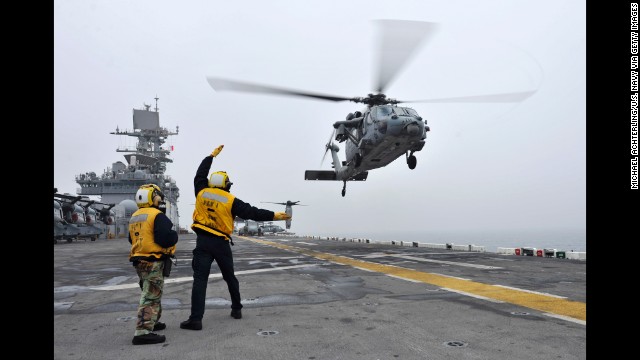 A U.S. helicopter takes off from the flight deck of the USS Bonhomme Richard during search-and-rescue operations on April 18.
A U.S. helicopter takes off from the flight deck of the USS Bonhomme Richard during search-and-rescue operations on April 18. 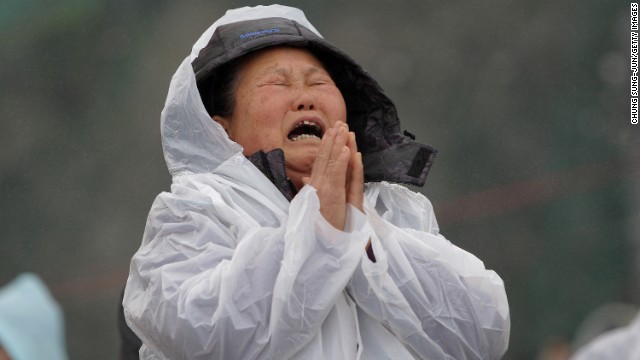 A woman cries as she waits for news on missing passengers April 18 in Jindo.
A woman cries as she waits for news on missing passengers April 18 in Jindo. 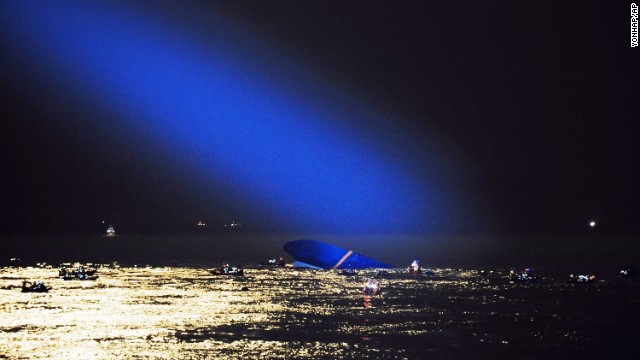 A searchlight illuminates the capsized ferry on Thursday, April 17.
A searchlight illuminates the capsized ferry on Thursday, April 17. 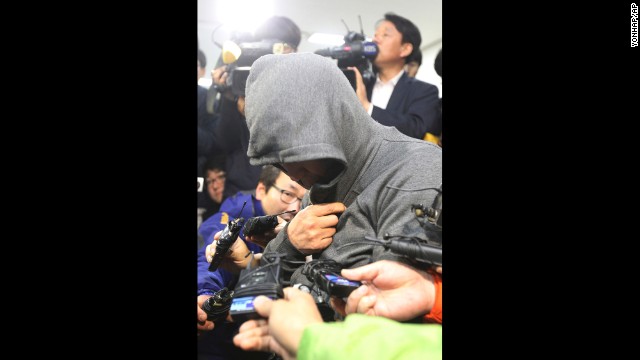 The ship's captain, Lee Joon Suk, arrives at the Mokpo Police Station in Mokpo on April 17. His head and face covered, he broke down in tears when reporters asked whether he had anything to say.
The ship's captain, Lee Joon Suk, arrives at the Mokpo Police Station in Mokpo on April 17. His head and face covered, he broke down in tears when reporters asked whether he had anything to say. 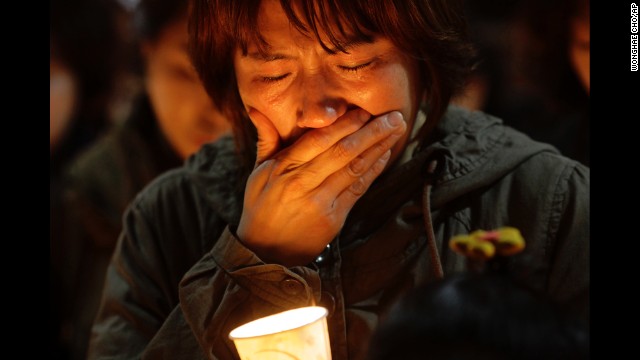 A woman cries during a candlelight vigil at Danwon High School in Ansan, South Korea, on April 17. Most of the people on board the ferry were high school students on their way to the resort island of Jeju.
A woman cries during a candlelight vigil at Danwon High School in Ansan, South Korea, on April 17. Most of the people on board the ferry were high school students on their way to the resort island of Jeju. 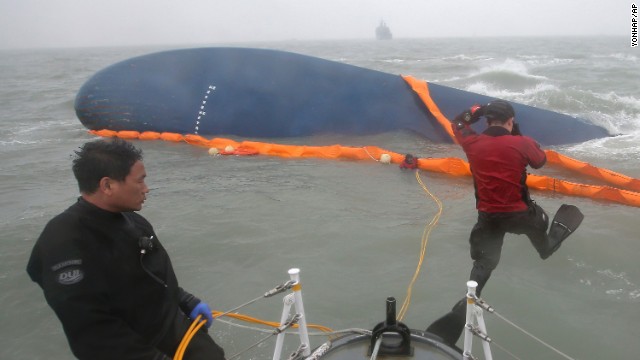 Rescue personnel dive April 17 during search operations.
Rescue personnel dive April 17 during search operations. 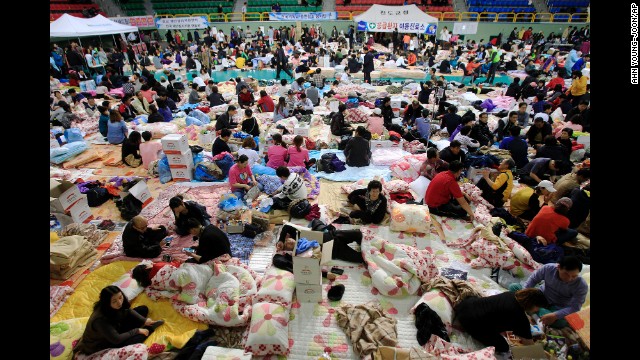 Family members of passengers aboard the sunken ferry gather at a gymnasium in Jindo on April 17.
Family members of passengers aboard the sunken ferry gather at a gymnasium in Jindo on April 17.  The body of a victim is moved at a hospital in Mokpo on April 17.
The body of a victim is moved at a hospital in Mokpo on April 17. 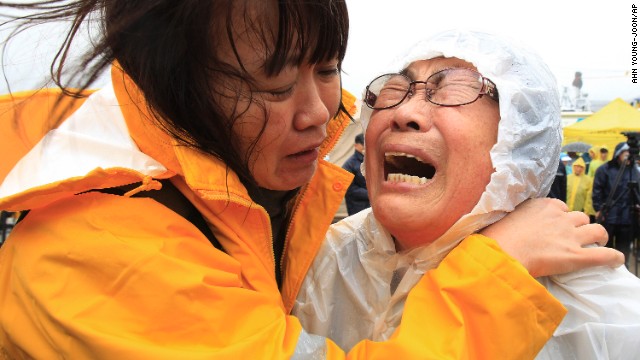 Relatives of a passenger cry at a port in Jindo on April 17 as they wait for news on the rescue operation.
Relatives of a passenger cry at a port in Jindo on April 17 as they wait for news on the rescue operation. 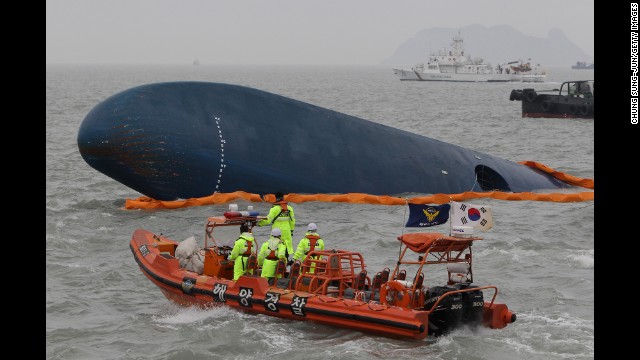 South Korean coast guard members and rescue teams search for passengers at the site of the sunken ferry on April 17.
South Korean coast guard members and rescue teams search for passengers at the site of the sunken ferry on April 17.  A relative of a passenger cries as she waits for news on Wednesday, April 16.
A relative of a passenger cries as she waits for news on Wednesday, April 16. 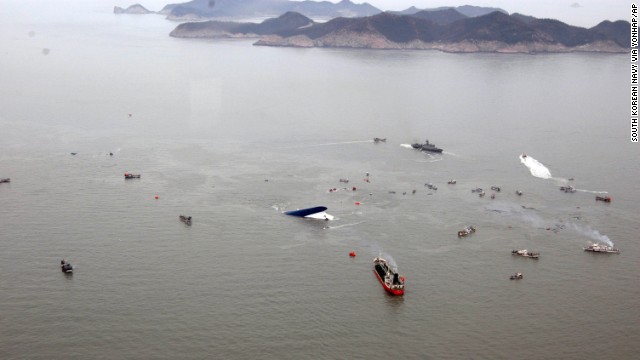 Rescue teams and fishing boats try to rescue passengers on April 16.
Rescue teams and fishing boats try to rescue passengers on April 16. 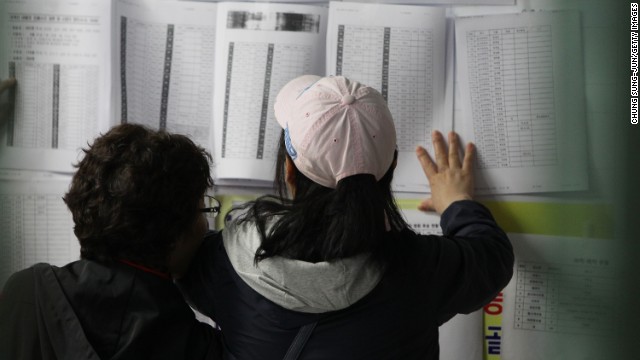 Relatives check a list of survivors April 16 in Jindo.
Relatives check a list of survivors April 16 in Jindo. 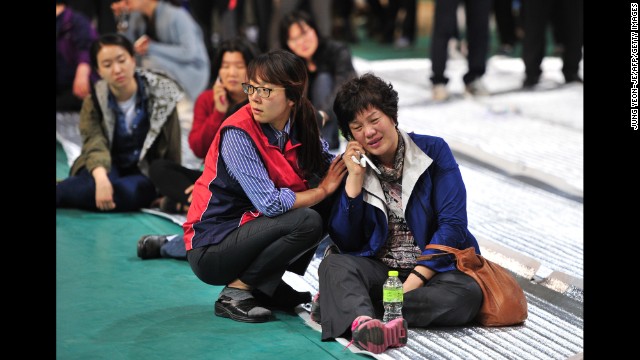 Relatives of missing ferry passengers wait for news at a gym in Jindo.
Relatives of missing ferry passengers wait for news at a gym in Jindo. 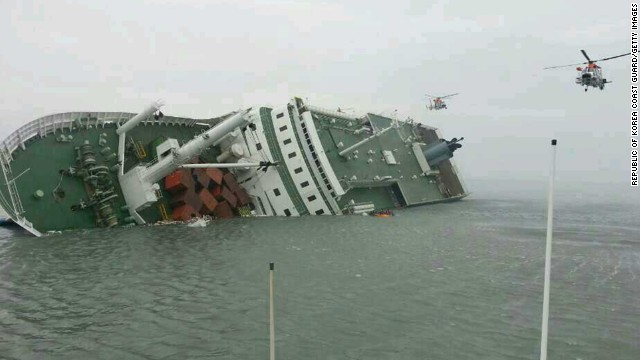 Rescue crews attempt to save passengers from the ferry on April 16.
Rescue crews attempt to save passengers from the ferry on April 16.  A South Korean coast guard helicopter lifts passengers off the vessel on April 16.
A South Korean coast guard helicopter lifts passengers off the vessel on April 16. 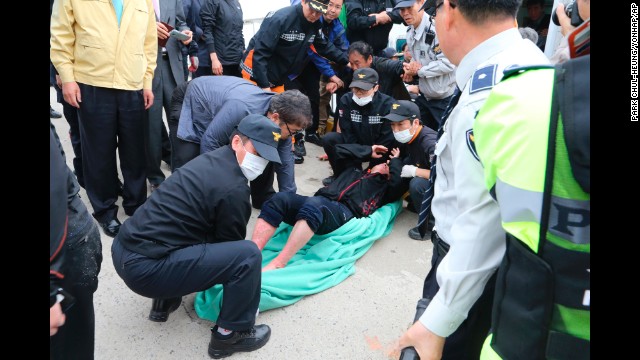 Police and rescue teams carry a passenger at the port in Jindo on April 16.
Police and rescue teams carry a passenger at the port in Jindo on April 16. 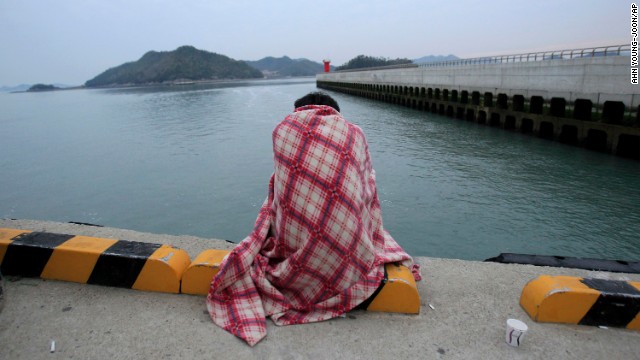 A relative waits for a missing loved one at the port in Jindo.
A relative waits for a missing loved one at the port in Jindo. 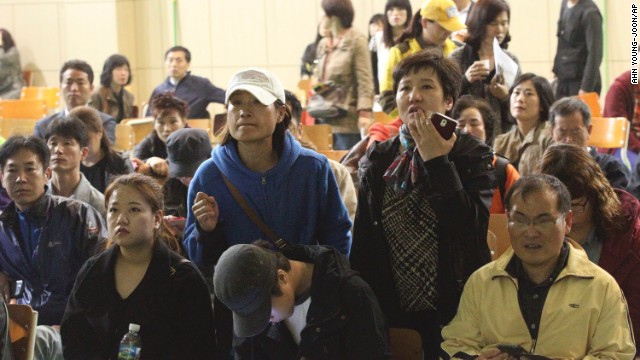 Parents at Danwon High School search for names of their children among the list of survivors. Ansan is a suburb of Seoul, the South Korean capital.
Parents at Danwon High School search for names of their children among the list of survivors. Ansan is a suburb of Seoul, the South Korean capital. 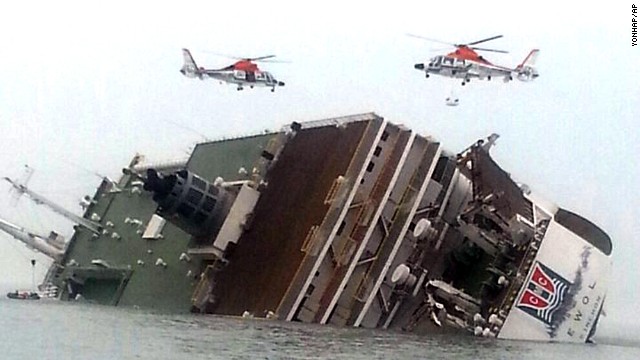 Helicopters hover over the ferry as rescue operations continue April 16.
Helicopters hover over the ferry as rescue operations continue April 16. 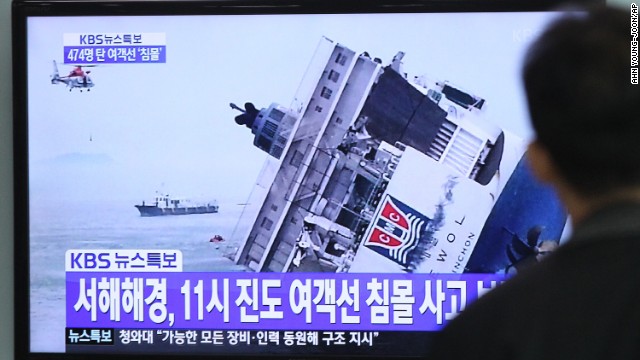 A man in Seoul watches a news broadcast about the sinking vessel.
A man in Seoul watches a news broadcast about the sinking vessel. 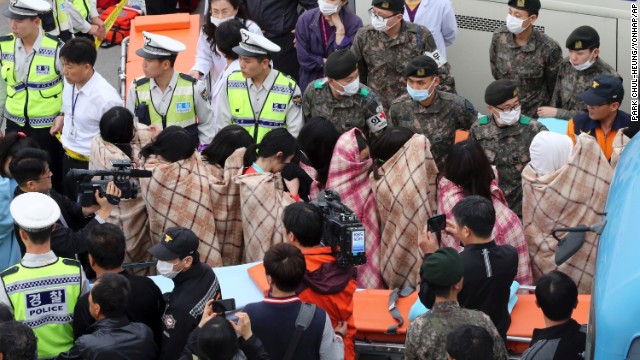 Officials escort rescued passengers April 16 in Jindo.
Officials escort rescued passengers April 16 in Jindo. 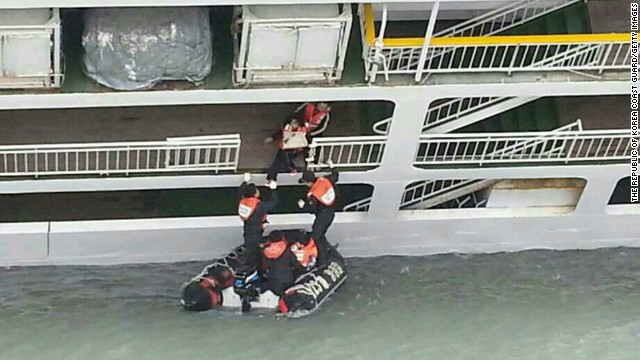 A passenger is helped onto a rescue boat on April 16.
A passenger is helped onto a rescue boat on April 16. 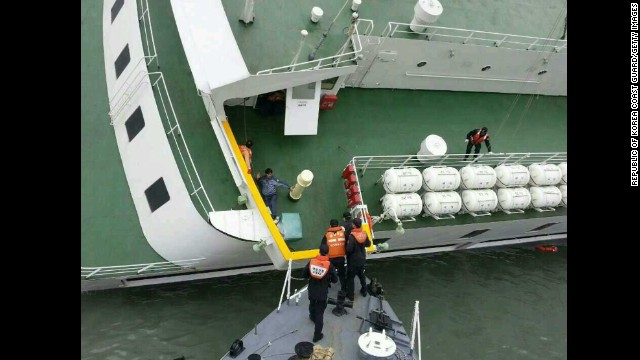 A passenger is rescued from the sinking ship on April 16.
A passenger is rescued from the sinking ship on April 16.  Photos: South Korean ship sinks
Photos: South Korean ship sinks "I'm sure she and the people around her are concerned about (how the ferry disaster has unfolded)," Straub said.
Both experts said they thought it was inconceivable that the president would resign.
A single body
South Korea's joint task force in charge of the search and rescue mission told CNN on Sunday that a closed-door meeting between rescuers and families was held to discuss possible new search tactics.
Rescuers explained that divers are having difficulty trying to reach the Sewol ferry floors close to the seabed, so officials are considering two options. They might use a special metal tool to cut through steel and other materials, or use small explosives to break down the wall. But the second option brings risk that some of the bodies could be damaged.
CNN is trying to get obtain reaction from the task force and the families to this meeting.
The talk comes 11 days after the ferry capsized. The search Sunday was suspended due to bad weather that made diving through the murky waters especially dangerous, but divers made an exception and went down to recover a single body.
A day earlier, divers found the bodies of 48 girls -- wearing their life jackets -- pressed into a room too small for so many people.
Divers believe that they will face the same scene again. There may be a second, similar room, where 50 more girls are believed to have been trapped when the ferry rolled over.
South Korean coast guard diver Kim Dong-soo said he had tears in his eyes when he heard about the accident.
"Even now, I'm searching as if I'm looking for my own children -- and other coast guards feel the same way," he told CNN. "I have two medical patches on me, have difficulty breathing and my head hurts. But it hurts the most in my heart, knowing those children are still in the cold water."
Those still diving face a search that is getting harder and slower.
Now they will head down deep for cabins near the seabed.
In the cramped spaces, divers have been battling a forest of drifting objects and doors forced shut by tremendous water pressure. Currents tug at the breathing tubes that keep them alive as they look for the dead.
There may be fewer bodies to retrieve, but divers have already searched the easily accessible places, said South Korean navy Capt. Kim Jin-hwang, commander of the rescue operation.
"But the navy will not stop until the last body is found," he said.
Ferry disaster's toll on South Korea's national psyche
Fisherman: Disaster haunts his sleep
Fisherman Kim Hyun-ho finds no peace when he lies down at night. The hundreds of dead or missing passengers from the Sewol ferry disaster haunt his sleep.
Their screams ring in his head. He has vivid memories of his rush to save them in his modest fishing boat off South Korea's coast 11 days ago.
Kim thinks he may have pulled 25 people from the frigid waters of the Yellow Sea, he said Saturday. But the man from a nearby tiny island of just 100 people feels no pride, only torment.
"It was hell. Agonizing. There were a lot of people and not enough boats, people in the water yelling for help. The ferry was sinking fast," he said.
He watched people trapped inside go under with the vessel yards in front of him. Then he heard on television how many people were sealed up in the ship.
The father of two grown children is heartbroken for the hundreds of parents who have lost theirs, those he could not save.
He's trying to fish again, but he's a changed man, he says.
Legal ramifications
As the effort inside the ship continues, South Korean authorities are pressing a criminal investigation into the sinking.
It's resulted in the arrests of the ship's captain and 14 other members. Prosecutors in Mokpo, South Korea, who are leading the ferry investigation, tell CNN that all the 15 crew members in charge of sailing and the engine room have been indicted and are being held in the Mokpo prison.
Yang Joong-Jin, the senior prosecutor for the investigation task force, said they all face charges of "causing death by abandoning (ship), and violation of the country's marine law, the Rescue and Aid at Sea and in the River Act."
Investigators also searched the company that owned the ferry and the home of the man whose family controls it, and conducted a wide-ranging probe into the country's marine industry.
Prosecutors have said that authorities have yet to determine what caused the sinking.
Leading theories include changes made to increase the ferry's passenger capacity, and shifting cargo.
On Friday, investigators checked out the Sewol's sister ship, the Ohamana, and said they found 40 of its life rafts weren't working, emergency slides to help evacuate passengers were inoperable, and equipment to tie down cars and cargo either was nonexistent or didn't work very well.
Like the Sewol, the Ohamana had been modified to add more passengers, the prosecutor's office said.
Investigators are looking into whether those modifications could have contributed to the Sewol's fate.
Kim Yong-rok, an opposition lawmaker who represents Jindo, an island near where the ship sank, told CNN that modifications to add 117 more passenger cabins to the ship raised the ferry's center of gravity.
On Friday, the South Korean Ministry of Oceans and Fisheries announced it would ask lawmakers to consider legislation prohibiting modifications to ships to increase passenger capacity.
Young crew member hailed as heroine
In recent disasters, captains didn't hang around
Students remember vice principal who took own life
Murky waters cloud the horror facing rescue divers
CNN's Nic Robertson reported from Jindo, South Korea. CNN's Ben Brumfield and Greg Botelho reported and wrote from Atlanta. CNN's Neda Farshbaf, Steven Jiang, Bradley Olson and Elena Kim also contributed to this report.


















































No comments:
Post a Comment